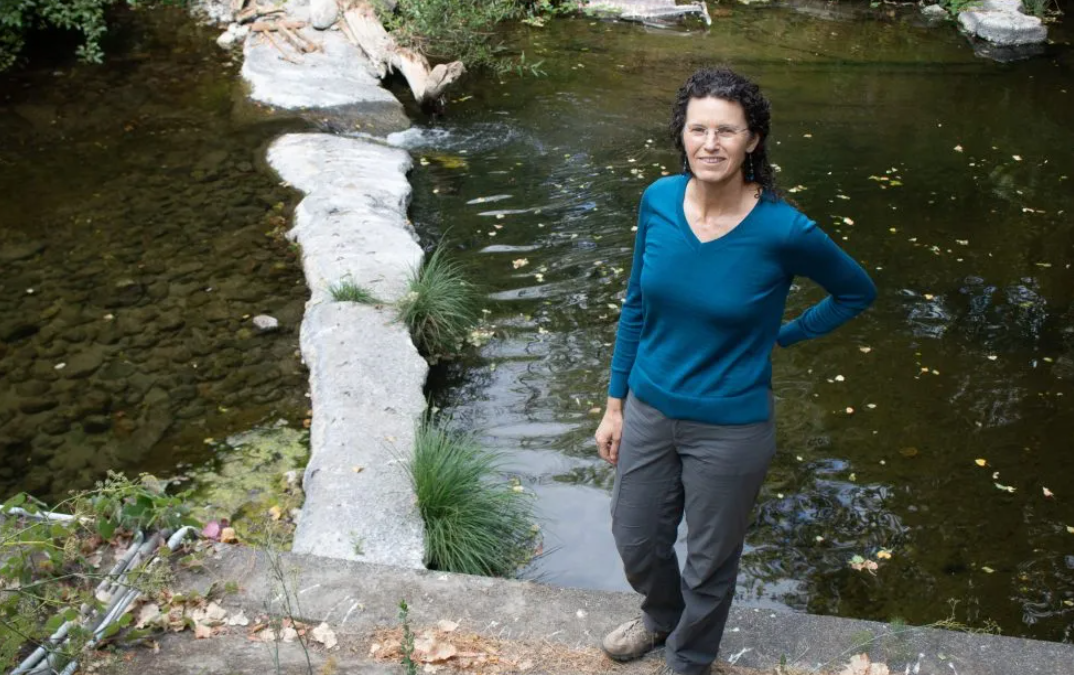Caitlin Cornwall is a Senior Project Manager at Sonoma Ecology Center. She also serves on the Sonoma Valley Groundwater Sustainability Agency Advisory Committee.
By Sonoma County Groundwater Sustainability Agency
When Caitlin Cornwall walks along Sonoma Creek and observes the native plant habitat, listens to the birdsong in the air and watches the current rippling downstream, she knows that the health of the ecosystem depends on having a sustainable groundwater supply below the surface. Caitlin, through her work as a project manager at Sonoma Ecology Center, has been monitoring the creek for a long time and understands the complex relationship between water underground and what flows above.
Sonoma Ecology Center monitors stream flow along Sonoma Creek through an agreement with the Sonoma Valley Groundwater Sustainability Agency. In “gaining reaches,” the water that flows in a creek comes from underground, while in “losing reaches” the stream filters water down through the creek bed and into the aquifer. Sonoma Ecology Center biologists want to better understand which areas are gaining reaches and which are losing reaches, to prioritize their habitat restoration efforts. The data they collect also helps the GSA understand where monitoring wells should be placed for the greatest benefit, and potentially identify locations for aquifer recharge projects.
“We need to remember that groundwater is a shared resource, and now we need to use it differently than we have in the past,” Caitlin said. “The supply is less, and the demand is greater. The only way to have dependable groundwater resources is to shift how we use it; it’s a scarce resource but it wasn’t always that way.”
To ensure that groundwater is sustainably managed, Sonoma Ecology Center wants to know more about water levels at various locations and times of year. Landowners can help by volunteering to monitor their wells on their own land, Caitlin said. “Groundwater is a shared community resource. We need to fill the gaps in information so that all of us know how much is stored in our aquifer at different times around the basin.”
Caitlin said she thinks taking an historical perspective on the aquifer is important. While the Sustainable Groundwater Management Act and the local GSAs were formed in response to drought over the last 10 years, the problems of groundwater depletion are nothing new in the region. Groundwater is harder to reach than it used to be, not just compared with decades ago but dating back to 1823 when Europeans introduced irrigation farming into the region.
Caitlin is a proponent of managing a sustainable water supply by creating or recreating low flat places that slow the flow of surface water, so it can sink or seep into the ground and naturally recharge aquifers. Referring to the controversial redevelopment likely to occur around Hanna Center and at the Sonoma Developmental Center, Caitlin said there is an opportunity for an upside, where carefully selected locations across hundreds of acres of land could be intentionally designed to slow down runoff, so that water can spread out and slowly help recharge subsurface groundwater.
Caitlin said she has heard people say that there is not enough water to build new housing in Sonoma Valley. She acknowledged the debate and its relationship to groundwater resources, but in her opinion, new, compact, infill housing is not a water supply issue. “New modest-size cottages or apartments are built according to the latest standards and are very water efficient, including their landscaping, compared with, say, my house that was built in the ’80s,” she said.
Individual households can make a difference for sustainability of the water supply, according to Caitlin. Anyone using groundwater on their landscaping can be an environmental hero if they shift their garden to native plants, she said. “You’ll leave a ton of water in the ground, plus planting with native plants creates much-needed habitat for pollinators, birds, and other animals.” She recommends using the Resilient Landscapes Coalition’s website to help make “right plant, right place” choices.
Another action under consideration by Sonoma Ecology Center to help groundwater recharge is to create beaver dam analogs, or dams constructed by people in the manner that a beaver would build, to slow the flow of water in streams and creeks. This would be most beneficial away from homes or any built structures, since they can exacerbate flood conditions when water is high. Caitlin notes that this approach must be done with eyes wide open, noting that beavers have been known to eat grapevines. Besides increasing groundwater recharge in the porous areas along streams, another benefit of beaver dam analogs is that they spread water into surrounding soils and vegetation, even during dry periods, and so create lush green vegetation that forms a fire break in case of wildfire.

